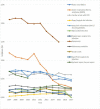Assessment of post-trauma complications in eight million trauma cases over a decade in the USA
- PMID: 33869787
- PMCID: PMC8009234
- DOI: 10.1136/tsaco-2020-000667
Assessment of post-trauma complications in eight million trauma cases over a decade in the USA
Abstract
Background: Trauma is associated with a significant risk of post-trauma complications (PTCs). These include thromboembolic events, strokes, infections, and failure of organ systems (eg, kidney failure). Although care of the trauma patient has evolved during the last decade, whether this has resulted in a reduction in specific PTCs is unknown. We hypothesize that the incidence of PTCs has been decreasing during a 10-year period from 2007 to 2017.
Methods: This is a descriptive study of trauma patients originating from level 1, 2, 3, and 4 trauma centers in the USA, obtained via the Trauma Quality Improvement Program (TQIP) database from 2007 to 2017. PTCs documented throughout the time frame were extracted along with demographic variables. Multiple regression modeling was used to associate admission year with PTCs, while controlling for age, gender, Glasgow Coma Scale score, and Injury Severity Score.
Results: Data from 8 720 026 trauma patients were extracted from the TQIP database. A total of 366 768 patients experienced one or more PTCs. There was a general decrease in the incidence of PTCs during the study period, with the overall incidence dropping from 7.0% in 2007 to 2.8% in 2017. Multiple regression identified a slight decrease in incidence in all PTCs, although deep surgical site infection (SSI), deep venous thrombosis (DVT), and stroke incidences increased when controlled for confounders.
Discussion: Overall the incidence of PTCs dropped during the 10-year study period, although deep SSI, DVT, stroke, and cardiac arrest increased during the study period. Better risk prediction tools, enabling a precision medicine approach, are warranted to identify at-risk patients.
Level of evidence: III.
Keywords: complications; morbidity; multiple trauma; postoperative complications.
© Author(s) (or their employer(s)) 2021. Re-use permitted under CC BY-NC. No commercial re-use. See rights and permissions. Published by BMJ.
Conflict of interest statement
Competing interests: None declared.
Figures
Similar articles
-
Determining the impact of culture on venous thromboembolism prevention in trauma patients: A Southwestern Surgical Congress Multicenter trial.Am J Surg. 2019 Jun;217(6):1030-1036. doi: 10.1016/j.amjsurg.2018.11.005. Epub 2018 Nov 20. Am J Surg. 2019. PMID: 30503515
-
Association of Hospital Participation in a Regional Trauma Quality Improvement Collaborative With Patient Outcomes.JAMA Surg. 2018 Aug 1;153(8):747-756. doi: 10.1001/jamasurg.2018.0985. JAMA Surg. 2018. PMID: 29800946 Free PMC article.
-
Pediatric vs Adult or Mixed Trauma Centers in Children Admitted to Hospitals Following Trauma: A Systematic Review and Meta-Analysis.JAMA Netw Open. 2023 Sep 5;6(9):e2334266. doi: 10.1001/jamanetworkopen.2023.34266. JAMA Netw Open. 2023. PMID: 37721752 Free PMC article.
-
Perioperative Blood Transfusions Are Associated with a Higher Incidence of Thromboembolic Events After TKA: An Analysis of 333,463 TKAs.Clin Orthop Relat Res. 2021 Mar 1;479(3):589-600. doi: 10.1097/CORR.0000000000001513. Clin Orthop Relat Res. 2021. PMID: 33165044 Free PMC article.
-
Is deep vein thrombosis surveillance warranted in high-risk trauma patients?Am J Surg. 1996 Aug;172(2):210-3. doi: 10.1016/s0002-9610(96)00154-7. Am J Surg. 1996. PMID: 8795534 Review.
Cited by
-
Deprescribing psychoactive drugs in older orthogeriatric patients: findings from the GIOG2.0 Italian survey.BMC Geriatr. 2025 Mar 1;25(1):138. doi: 10.1186/s12877-025-05695-1. BMC Geriatr. 2025. PMID: 40025484 Free PMC article.
-
Pulmonary miRNA expression after polytrauma depends on the surgical invasiveness and displays an anti-inflammatory pattern by the combined inhibition of C5 and CD14.Front Immunol. 2024 Aug 29;15:1402571. doi: 10.3389/fimmu.2024.1402571. eCollection 2024. Front Immunol. 2024. PMID: 39267761 Free PMC article.
-
Frequency of posttrauma complications during hospital admission and their association with Injury Severity Score.Clin Exp Emerg Med. 2023 Dec;10(4):410-417. doi: 10.15441/ceem.23.053. Epub 2023 Jul 13. Clin Exp Emerg Med. 2023. PMID: 37439140 Free PMC article.
-
Assessing the utility of a sliding-windows deep neural network approach for risk prediction of trauma patients.Sci Rep. 2023 Mar 30;13(1):5176. doi: 10.1038/s41598-023-32453-3. Sci Rep. 2023. PMID: 36997598 Free PMC article.
-
Cardiovascular parameters on computed tomography are independently associated with in-hospital complications and outcomes in level-1 trauma patients.Eur J Trauma Emerg Surg. 2023 Jun;49(3):1295-1302. doi: 10.1007/s00068-022-02168-7. Epub 2022 Nov 27. Eur J Trauma Emerg Surg. 2023. PMID: 36436070 Free PMC article.
References
LinkOut - more resources
Full Text Sources
Other Literature Sources
Research Materials

